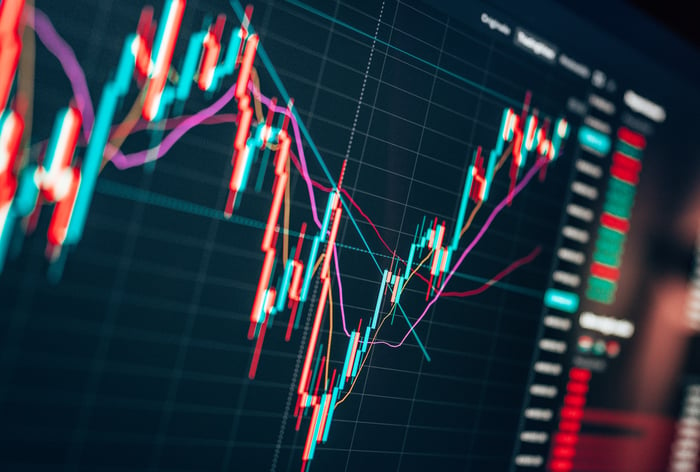Over long periods, Wall Street is a money-making machine. But over shorter periods, anything goes.
Since the start of the decade, Wall Street's major stock indexes have been whipsawed, with the growth-driven Nasdaq 100 taken for the wildest of rides. The Nasdaq 100 is an index comprised of the 100 largest nonfinancial companies listed on the Nasdaq exchange. After losing 33% of its value in 2022, the Nasdaq 100 has catapulted higher by 42% through the end of August.

Image source: Getty Images.
But in spite of this mammoth rally, the Nasdaq 100 still sits about 7% below its all-time high, which was set in late December 2021. For long-term investors, it means deals can still be found.
At the same time, it's equally important to recognize that not all companies within a major index are necessarily worth buying.
With these caveats in mind, what follows are two Nasdaq 100 stocks that are surefire buys in the month of September, as well as another Nasdaq 100 stock that investors should avoid.
Nasdaq 100 stock No. 1 that's a surefire buy in September: Amazon
The first Nasdaq 100 stock that stands out as a phenomenal buy in September is none other than e-commerce leader Amazon (AMZN 1.62%).
Like every publicly listed company, Amazon has headwinds to contend with. Perhaps the biggest challenge it'll face in the coming quarters is the health of the U.S. and global economy. With a number of economic datapoints suggesting a U.S. recession is coming, the expectation would be for sales at Amazon's top revenue-generating segment, its e-commerce marketplace, to slow. A report from eMarketer in 2022 estimated that Amazon accounts for just shy of 40% of all U.S. online retail sales.
However, the biggest mistake investors can make is placing too much weight on the performance of Amazon's highest-revenue channel. The online marketplace is a low-margin segment that accounts for little of the company's operating cash flow or income. What's far more important is that Amazon's three ancillary segments, which generate the bulk of its operating cash flow, are firing on all cylinders -- and hint, hint, they are!
The most important of these is Amazon Web Services (AWS), which is the world's leading cloud infrastructure service provider. Enterprise cloud spending is still in its early innings, and AWS is generating about $88.6 billion in annual run-rate sales. Even though AWS makes up just a sixth of Amazon's total sales, it's regularly responsible for 50% or more of its operating income.
The other two core segments that are still growing by a double-digit percentage on a currency-neutral basis are advertising services and subscription services. The later has seen over 200 million people worldwide sign up for a Prime membership.
Additionally, investors are approaching Amazon's valuation from an odd angle. While the traditional price-to-earnings (P/E) ratio works wonders for mature businesses, Amazon is reinvesting the bulk of its cash flow back into high-growth initiatives and logistics. This makes its cash flow from operations a far better tool to gauge its relative "cheapness." After closing every year in the 2010s at between 23X and 37X cash flow, shares of the company can currently be purchased for less than 13X Wall Street's consensus cash flow per share estimate in 2024. That's a bargain for an industry leader like Amazon.
Nasdaq 100 stock No. 2 that's a surefire buy in September: Intuitive Surgical
A second Nasdaq 100 stock that's a surefire buy in the month of September is robotic-assisted surgical systems developer Intuitive Surgical (ISRG 0.74%).
The biggest hurdle for Intuitive Surgical over the past three-plus years has been overcoming COVID-19-related challenges. Specifically, I'm talking about elective procedures being pushed back to a later date because of COVID-19 or some other pandemic-related/adjacent issue. Pushing back elective procedures has, at times, modestly slowed Intuitive Surgical's double-digit growth rate.
However, the adverse impacts associated with the pandemic have been waning, which gives Intuitive Surgical's stock a clear path higher. Specifically, three clear-cut catalysts stand out for the company.
To begin with, Intuitive Surgical had about a two-decade head start on its competition. As of halfway through 2023, it had 8,042 of its da Vinci surgical systems installed in hospitals and surgical centers worldwide. No other company is even remotely close to this figure.
To add to this first point, hospitals and surgical centers tend to remain customers for the long run. Given the cost of the da Vinci surgical system ($0.5 million to $2.5 million) and the time it takes to train surgeons, buyers are highly unlikely to ever switch to a competing robotic-assisted solution in the operating room.
The second catalyst is the company's razor-and-blades operating model. For Intuitive, the "razor" is the da Vinci surgical system. While these systems are pricey, they're also costly to build, and therefore result in only mediocre margins. The "blades" refer to the instruments and accessories sold with each procedure, as well as the servicing done on the da Vinci surgical system. These are considerably higher margin sales channels, and they're continually becoming a larger percentage of total sales over time.
The final catalyst for Intuitive Surgical is its innovation. In addition to just scratching the surface with da Vinci in colorectal, thoracic, and general soft tissue surgeries, Intuitive Surgical offers a host of other innovations, such as its Ion Platform for ultra-precise, robotic-assisted lung biopsies. The market share runway for da Vinci, coupled with the company's other innovation in the operating room, should lead to a sustained double-digit growth rate.

Image source: Getty Images.
The Nasdaq 100 stock that can be avoided like the plague in September: Moderna
Unfortunately, not every Nasdaq 100 stock is going to be a winner. Though it's been one of the hottest stocks on Wall Street since the COVID-19 pandemic was declared in 2020, biotech stock Moderna (MRNA 0.66%) makes for an easy avoid in the month of September.
To be fair, Moderna does have a few things working in its favor. For example, Moderna and Merck announced positive results from their phase 2b combination trial evaluating Merck's cancer immunotherapy Keytruda and Moderna's experimental vaccine mRNA-4157 as a treatment for patients with resected high-risk melanoma. This offers hope that Moderna can expand beyond its only current indication (COVID-19 vaccines).
Additionally, Moderna closed out June with close to $8.5 billion in cash, cash equivalents, and investments. There's plenty of capital here to continue conducting research. But this is where the praise ends.
The biggest problem for Moderna is that its COVID-19 vaccine, Spikevax, isn't the beast it was as recently as last year. With COVID-19 vaccines shifting from advanced purchase agreements with governments to the private market, Spikevax will face tougher competition. This includes Novavax, whose protein-based vaccine was late to the party in 2022, but will be ready to roll this year.
More importantly, with the worst of the COVID-19 pandemic likely in the rearview mirror, the public's desire to get booster shots appears to be fading. Only 17% of eligible Americans have received an updated bivalent COVID-19 booster shot over the past year, and this figure could decline even more as time passes.
Meanwhile, Moderna has gone from jaw-dropping profits to eye-numbing losses. After generating more than $19 billion in sales last year, the company's COVID-19 sales are expected to come in around $7 billion (at the midpoint) in 2023 and possibly fall to a little over $6 billion in 2024, based on Wall Street's estimates. In the two-year stretch from Jan. 1, 2023 to Dec. 31, 2024, analysts believe Moderna could lose an aggregate of $3.4 billion. That's a steep loss for a company valued at $43 billion, whose shares have more than quadrupled since the pandemic began.
With only a single area of focus currently generating sales, Moderna has a mountain of built-in risk. This makes it an easy stock to avoid in September.





